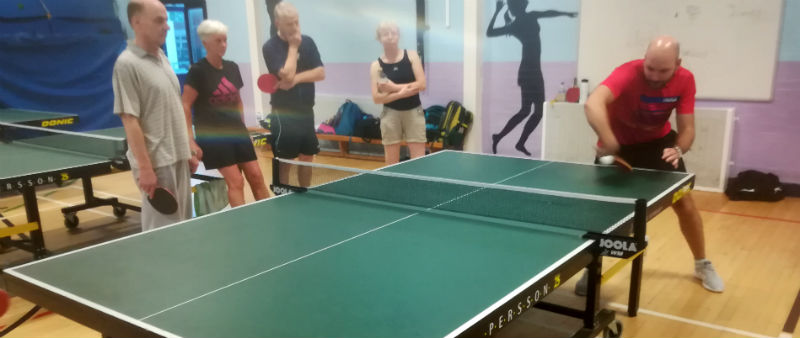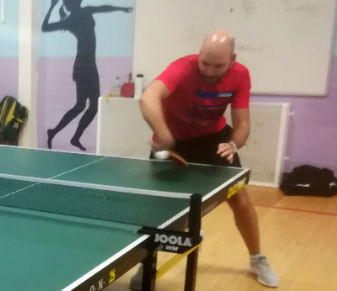
How do you return a backspin serve, which lands short, in the middle of the table?
A lot of players would push. Attacking players may try to flick. These are the two most typical answers to the question.
But actually you have far more options than you think. There is more than one way to push and more than one way to flick. You can be very creative in how you return a short backspin serve.
I picked up some great tips in a group coaching session I attended this week, which was run by Craig Bryant (a former England international player and now a professional coach).
In this blog post I share some of the things I learnt from Craig about how to improve the variation of your service returns.
Receiving options
So let’s go back to the original question: how do you return a backspin serve, which lands short, in the middle of the table? I have already mentioned two options – push and flick – but let’s examine these options in more detail.
For the push, I could do:
- a standard, safe push, with medium backspin
- a fast, deep push with heavy backspin
- a touch shot, which lands just over the net
So that’s three options, but for each option, I could play the shot to these positions:
- my opponent’s wide backhand
- my opponent’s wide forehand
- my opponent’s crossover (their playing elbow / hip)
And because the ball is served in the middle of the table, I could easily return the serve with either my backhand or forehand. So for the push return alone, I now have 18 possible options.
For the standard flick, I also have many options. I could do:
- a fast flat flick
- a fast spinny flick
- a slow spinny flick
Again I could play these to different positions and use either my backhand or forehand, so I have another 18 options (although it is much harder to to a fast spinny flick with your forehand, so I will reduce this to 17 options).
I could also do one of these more unusual flicks:
Both of these are done with the backhand, but can be placed to the backhand side, forehand side and crossover, so that’s 6 more options.
So now I have 41 options of how I can return a backspin serve, which lands short, in the middle of the table.
If you also add in deception – shaping up to play a shot in one direction and switching to the opposite direction at the last moment – you have even more options. Too many options for my brain to work out!
Which option should you use?
Is one option better than the rest? No, not necessarily. A lot of it depends on context – who your opponent is and what’s happening during a match.
For example, a fast, deep push with heavy backspin may be effective at the start of a match when an opponent is a little tense and hesitant, but if you overuse it, your opponent may adapt and start attacking these pushes consistently. In which case, mixing in touch returns and flicks will keep your opponent guessing.
Or a fast, spinny backhand flick may be the perfect way to return a short backspin serve against a slow opponent or an opponent who struggles to control topspin. But it may be less effective against an opponent who likes to get straight into quick topspin rallies. Instead switching to some slow spinny flicks or touching the ball short may be much more effective.
Or doing something unusual, like a banana or strawberry flick, may completely confuse a player who seems to cope with all other types of return of serves.
So different things will work against different players at different times of the match. If you have the ability to vary how you return serves, you should have options which will give most players difficulty.
Prioritising what to learn
All of this might seem overwhelming. There are so many options, how can you possibly master them all? It’s very tough to master everything, if you only have limited practice time.
I think it’s best to start with variations which are a development of strokes you can already execute.
For example, if you already have decent pushing technique, it should be quite straight forward to develop your steady push into a fast, heavy backspin push.
Or if you can already flick, it should be straightforward to develop the stroke so you can flick at different speeds, with different levels of spin and to different positions.
So start with the easy wins and then move onto to other variations which you find more difficult to do.
For my game, I’m going to be working on my touch shot, a fast, heavy backspin push and flicking with more spin.
I’m also going to experiment with the strawberry flick. I actually found the motion quite easy to do and it really did seem to cause panic and confusion when I did against other players in the group coaching. A nice little variation to have to mess up my opponents! But the banana flick, I found tricky, so I’ll probably leave this for another time.
Final thoughts
This blog post has been looking at different ways to return only one type of serve. But you can apply this principle to other serves too.
Craig showed us how you can also return a short topspin serve with a push, touch and flick. With a quick reading of the serve, good timing and good bat control, you can make the ball do what you want it to do, rather than the server dictating what type of shot you play.
You don’t have to master all variations to every kind of serve. But developing a few different spin and placement variations will make a big difference to the quality of your service returns.
Returning serves – online course
If you would like more help on returning serves, I recommend joining Tom’s TT Academy. I have a 10 lesson in-depth online course all about returning serves. The lessons include…
- Returning backspin serves
- Returning topspin serves
- Returning sidespin serves
- Reading service spin
- Learning from mistakes
- Where to stand when returning serves
- How to apply pressure on your opponent when returning serves
You will also get access to a wide range of coaching content, including
- in-depth courses
- training drills
- fitness videos
- robot training videos
- member discussions
- video analysis
- skill challenges
- coaching clinic
- and lot’s more!
You can access all this content for less than £1 per week. New content is added regularly. Join hundreds of table tennis players around the world today at www.tomsttacademy.com

